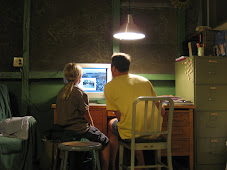We recently did three chemistry experiments to supplement our reading about matter.
First, we dissolved a nail in hydrochloric (muriatic) acid. We diluted the acid with about 50 percent water and put it in a clear glass jar. It took about two weeks for the nail to dissolve. Here's what we observed and learned.
C: At first we saw the nail bubbling and the vinyl coating was separating from the nail.
Sam: The nail was shiny. After five days the green vinyl was really peeling from the nail, and there were few bubbles. The nail was grey and dull, the water had turned black and smelled like burnt rubber. We took off the lid to see if it would make more bubbles. It didn't.
C: The liquid was bluish and there was black stuff on the bottom and floating on top. In the end there was nothing but blue liquid.
Where did the nail go?
Sam: It melted kind of...dissolved. It was in the water.
What made the smell?
C: Rusting and stuff. (Sam: The gases.)
We discussed the idea of a chemical reaction and pointed out three big points:
The total number of atoms of each element is the same before and after the reaction. All the metal is still there, but it's in the acid or the black stuff.
The form of the matter may change. The hydrogen from the HCl is gas or water now. The iron is no longer in the form of a nail.
Heat may be created or absorbed. Not applicable this time.
Our next experiment was about the reactivity of various metals in muriatic acid.
We put different metals in test tubes with muriatic acid (Dad did this part).
Sam: We observed that the lead and copper had not done anything in the acid. The aluminum was overflowing with bubbles, so we had to pour it out into our safety bucket of water. The steel made tiny bubbles, and the zinc was bubbling but not too much.
 C: The zinc made much bubbles at first but then stopped once the zinc had been completely eaten away. (We used a galvanized nail and it had been stripped down to the steel.) Aluminum is extremely reactive in acid.
C: The zinc made much bubbles at first but then stopped once the zinc had been completely eaten away. (We used a galvanized nail and it had been stripped down to the steel.) Aluminum is extremely reactive in acid.
For the second part of our experiment we neutralized hydrochloric acid with baking soda.
C: I called this part HCl + NaHCO3 = Useless goop.
Dad: We had generated a small amount of waste acid that we needed to dispose of safely.
Sam: We used a test tube with acid and distilled water.
Dad: We used a pool test kit to check the ph of our acid as we gradually added baking soda. We noticed that adding baking soda made bubbles. When the acid was neutralized we didn't get many bubbles any more. We used the same technique to neutralize the leftover acid from our nail experiment.
Our third experiment was called Properties of Materials when Heated/Setting Things on Fire.
We used a propane torch to heat small samples of materials and wrote down our observations. We tested many materials. Here are our favorites.
C: Copper made green flame and melted into a blob on the end of the wire. Using a fat wire didn't work. We had to use a super-duper skinny wire.
Sam: My favorite was steel wool, because it made fire works. It made sparks and orange flame.
C: I liked the brass tea strainer because it acted much like the thin copper wire. It made a green flame but didn't melt.
Sam: Baking soda melted, but baking powder burned. They both made orange flames, and the baking powder had a burnt carbon smell.
Dad: Most of all we thought about the different ways we could make observations. No garages were harmed in performing this experiment.
C: We had a lot of fun with this experiment, and if you try it I bet you will too.
skip to main |
skip to sidebar


Where will their adventures take them?

We moved to www.eurekafamily.blogspot.com in June 2011

TinTin and Snowy

Where will their adventures take them?

About Us
- C =Boy, aged 13, K=Girl (AKA Kit), aged 11, Mom & Dad
- We are a couple of kids in the southern Sierra Foothills. We (used to) homeschool and like to travel and do other stuff kids like to do. We also like to ride bikes. We named our Blog "Eureka!" because that's what Tintin says when he discovers something, and its the slogan for our state, California. (And, Mom made us do it.)
Our Pets
- Acrobat (chicken)
- Bertha (chicken) (RIP)
- Cedar (chick)
- Chessie the superkitten! aka Fuzzo or Baby Bookins
- Chipper (chick) (RIP)
- Glay (chickenRIP)
- Lulu (dog who thinks she's a cat)
- Pecker & Blackie (twin chickens)
- Poppy (chicken)
- Pumpkin (chicken)
- Rodher (Chicken)
- Sneezer (chick) (RIP)
- Toeser (scaredy cat)
- Weechee (ladybug) (probably dead)
- Whiner RIP (cat who thought she was a dog)
- Witchking (chick) (RIP)
Favorite Movies
- Strange Brew
- Harry Potter Series (both of us)
- Star Wars Series (C)
- Strange Brew
- Lord of the Rings
Favorite Books
- Ranger's Apprenticee
- Percy Jackson
- Sammy Keyes
- The Floating Island
- Hitchhiker's Guide to the Galaxy
- Captain Bluebear
- Lord of the RIngs
- Harry Potter Series